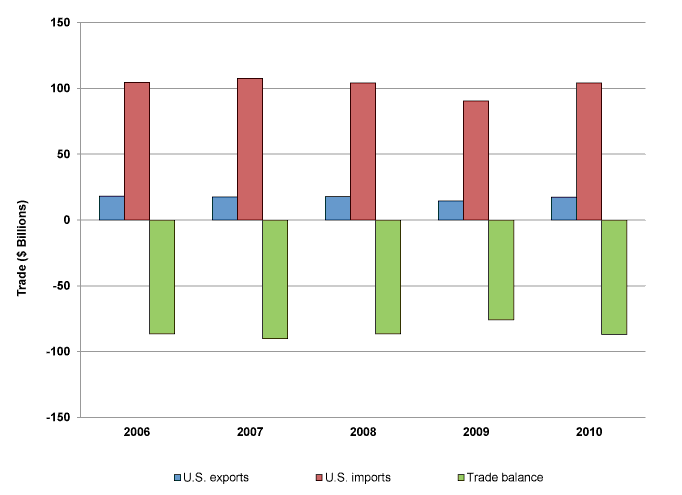View Section in Publication :: Return to Overview

Key Economic Trends
- In 2010, the U.S. trade deficit in textiles and apparel increased by 14 percent to $86.8 billion, while the deficit in footwear increased by 17 percent to $20 billion. Heightened U.S. consumer demand for these goods, which increased by 5 percent in response to the rebounding domestic economy, drove much of these deficits.
- U.S. exports of textiles and apparel increased by 18 percent to $17.4 billion in 2010, as shipments increased to regional trading partners under NAFTA and DR-CAFTA. Much of the increased demand for textile exports, such as fibers, yarns, and fabric, can be linked to increased U.S. demand for finished apparel imports from these trading partners.
- China was by far the largest supplier of textiles and apparel, as well as footwear, to the U.S. market, accounting for 76 percent of all U.S. footwear imports and 40 percent of total textiles and apparel imports. U.S. imports of these goods increased from other leading Asian suppliers including Vietnam, India, Indonesia, and Bangladesh.
Trade Shifts from 2009 to 2010
- U.S. trade deficit: Increased by $10.9 billion (14 percent) to $86.8 billion
- U.S. exports: Increased by $2.7 billion (18 percent) to $17.4 billion
- U.S. imports: Increased by $13.6 billion (15 percent) to $104.2 billion
Selected Product Shifts
USITC Publications
- Advice Concerning Possible Modifications to the U.S. Generalized System of Preferences, 2010 Special Review, Certain Sleeping Bags Investigation No. 332-513 USITC Publication 4141 (amended).
- Earned Import Allowance Program: Evaluation of the Effectiveness of the Program for Certain Apparel from the Dominican Republic Investigation No. 332-503 USITC Publication 4175.
- Certain Textile and Apparel Imports from China: Statistical Reports, Annual Compilation 2010, Investigation No. 332-501, USITC Publication 4230, May 2011.
- Investigation No. 1205-8: Certain Footwear: Recommendations for Modifying the Harmonized Tariff Schedule of the United States, USITC Publication 4178, August 2010.
- Certain Textile Articles Containing Rayon and Other Manmade Fibers: Effect of Modifications of NAFTA Rules or Origin for Goods of Canada and Mexico and Certain Textile Articles Containing Acrylic and Modacrylic Fibers: Effect of Modifications of NAFTA Rules of Origin for Goods of Canada, Investigation Nos. NAFTA 103-023 and NAFTA-103-024, USITC Publication 4119, December 2009.
- Textiles and Apparel: Effects of Special Rules for Haiti on Trade Markets and Industries, Investigation No. TR-5003-1, USITC Publication 4016, June 2008.
- Denim Fabric: Commercial Availability in AGOA Countries During Fiscal Year 2009, Investigation No. AGOA-003, USITC Publication 4027, August 2008.
- Certain Yarns and Fabrics FY 2009: Effect of Modification of the U.S.-Singapore FTA Rules of Origin, Investigation No. FTA-103-022, USITC Publication 4096, August 2009.
Other Government Resources
- Office of the U.S. Trade Representative (USTR), Office of Textiles
- U.S. Department of Homeland Security, U.S. Customs and Border Protection, Office of International Trade, Textile/Apparel Policy and Programs
- U.S. Department of Commerce, International Trade Administration, Office of Textiles and Apparel (OTEXA)
Other Resources
- American Apparel and Footwear Association
- National Council of Textile Organizations
- United States Association of Importers of Textiles and Apparel
- Footwear Distributors and Retailers of America
- National Council of Textile Organizations (NCTO)
- United States Association of Importers of Textiles and Apparel (USA-ITA)
